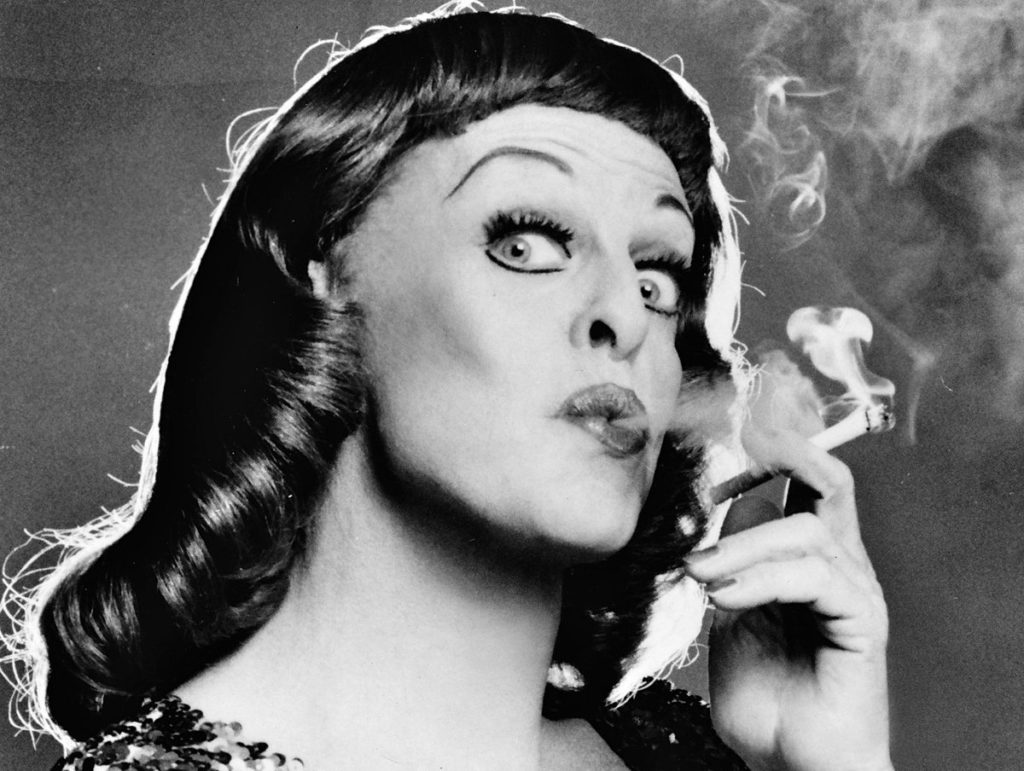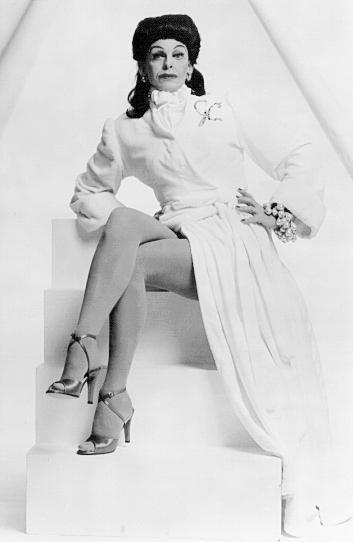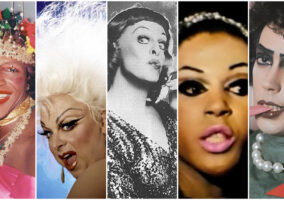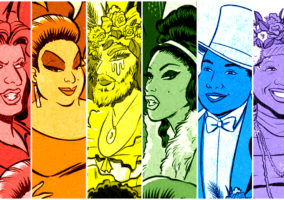
Charles Pierce was one of the most famous drag queens of the latter 20th Century, having achieved a level of renown and recognition by the general public that only a handful of drag performers ever managed before Divine and RuPaul came along to change the game. Born in 1920 in Watertown, New York, young Charles was a flamboyant, theatrically inclined young baby gay who later reminisced about rummaging through his grandmother’s old clothing trunks in order to put on living room and backyard shows as Mae West. Like so many drag performers, his youthful play time turned into a passion and then a career for him. But not without a few stops along the way. After all, most men who wanted to pursue performing careers circa World War II didn’t automatically assume they’d be doing so in a dress.
In fact, for the longest time, his nascent performing career had no drag to be found anywhere in it. After bopping around a succession of gigs in the 1940s, from department store Santa to radio work to summer stock, Pierce put together a little cabaret act in the early ’50s consisting of a little singing, some patter and jokes, and salutes to his first great loves, the grand female stars of Hollywood’s golden age. In the early years of his act, he performed his impressions of these ladies without the use of drag because it was too risky a proposition for a single performer on a stage to step out in women’s clothing. The laws of the period differed from town to town and state to state, but for the most part, it was illegal for men to perform in women’s clothing. They did it all the time, of course. We wouldn’t have the long history of drag performing if they didn’t. But it was perhaps a little easier for the big drag revues of the period to get away with such things, as opposed to single performers. In most instances, the local law could be paid off by the owners of these revues to look the other way or to fail to enforce the cross-dressing laws of the area. But for Charles Pierce, alone on a stage doing his Bette Davis or Gloria Swanson impersonations, it was perhaps a smarter choice to rely on props rather than wigs and corsets. There was much less chance of him winding up in jail.
Of course he did go on to a legendary career as a drag queen and eventually compiled a collection of thousands of glamorous dresses and gowns, but in the early years, he’d rely on a feather boa here and a big hat there to get his impression across. And in the end, that may have been what made him such a legend. His impressions of women like Davis, Swanson, Joan Crawford, Mae West, Katharine Hepburn and Carol Channing were biting, hilarious, on-point and witty. His years of relying on his own talent rather than the trappings of drag is what elevated his performing style. In fairness, we’d say none of his impressions of these women were what you’d call uncanny, but that wasn’t really the point. Many celebrity female impersonators, like the legendary Jim Bailey, made their name through the precision of their performances, which often left audiences wondering if they’d inadvertently seen the real thing. Pierce was a comic and a classic performer in his own right. He was less interested in being perfect in his mimicry and far more interested in making sure his audiences left good and entertained – which they did; ecstatically so.

His was very much an old-school form of drag; schticky, bawdy, vaudevillian, and vaguely politically incorrect (although not too much because his audiences were more or less mainstream). The jokes flew fast and furious and the patter never stopped unless it was to sing a line or two of a song – then it was right back to asides and bon mots and bitchy-queen sarcasm. “Drag is dirty work,” he’d quip, “But somebody has to do it.” Still, he didn’t call himself a drag queen all that regularly. He preferred instead to use a phrase a critic bestowed on him: “male actress.” It was more accurate than it sounds, since Pierce enjoyed a career bump in the ’70s and ’80s (due partially to the fact that he was a popular talk show guest who could always be relied on to make the host and audience laugh) that allowed him to pursue his longtime dream of acting. He made guest appearances (sometimes in drag, sometimes not) in a whole bunch of shows, from Wonder Woman to Laverne & Shirley to Designing Women. He capped his long career off by appearing in the movie version of Harvey Fierstein’s Torch Song Trilogy as the drag queen Bertha Venation.
He died in 1999, his longtime friend Bea Arthur sitting dutifully by his bedside when he did. Other long-time friend Carol Channing said at his funeral “He did Carol Channing better than I did.” Whenever you see the queens on RuPaul’s Drag Race struggling to perfect their celebrity impersonations for the Snatch Game challenge, you’re seeing the new generation continue the work of Charles Pierce and hundreds of other drag queens of the 20th Century who made their names by impersonating their favorite divas to appreciative audiences looking for a little Hollywood glamour in their live entertainment.
In the end, nothing we write about Charles Pierce will inform you as much as simply watching him perform. Thankfully, a good deal of his work has been recorded and can be found fairly easily. A sampling:
For more pictures, interviews and recordings of Charles Pierce, we invite you to visit the stunning Queer Music Heritage archive, which was an invaluable resource to us in writing our book. The section on Pierce can be found here.
Queen in the North Sophie Turner for Port Magazine Next Post:
Cathy Cambridge and Meghan Markle at Trooping the Colour Ceremony 2019
Please review our Community Guidelines before posting a comment. Thank you!


